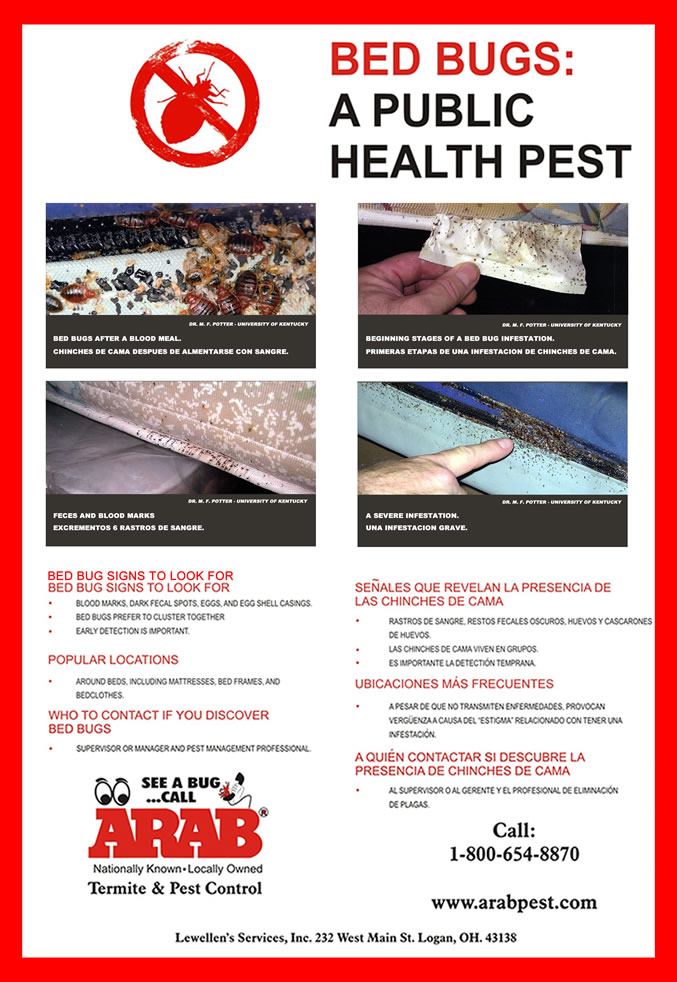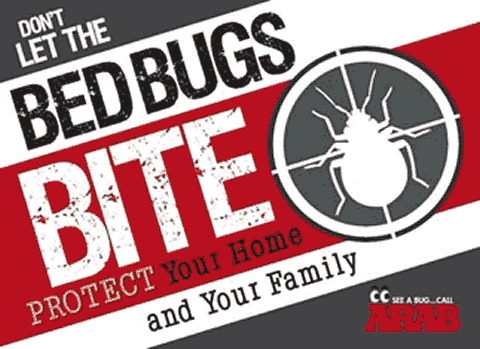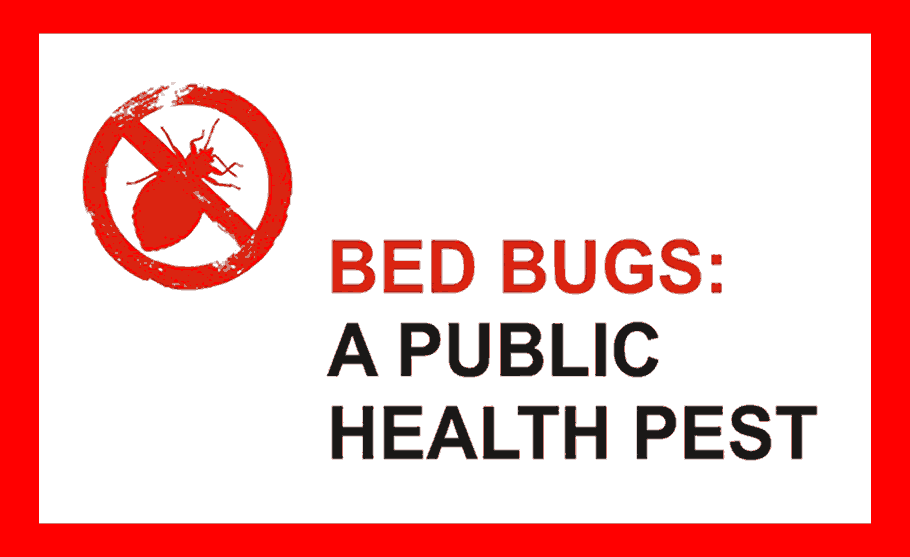Bed Bugs
Information provided by Ohio State University.
 Bed bugs are parasites that preferentially feed on humans. If people aren't available, they instead will feed on other warm-blooded animals, including birds, rodents, bats, and pets.
Bed bugs are parasites that preferentially feed on humans. If people aren't available, they instead will feed on other warm-blooded animals, including birds, rodents, bats, and pets.
Bed bugs have been documented as pests since the 17th century. They were introduced into our country by the early colonists. Bed bugs were common in the United States prior to World War II, after which time widespread use of synthetic insecticides such as DDT greatly reduced their numbers. Improvements in household and personal cleanliness as well as increased regulation of the used furniture market also likely contributed to their reduced pest status.
In the past decade, bed bugs have begun making a comeback across the United States, although they are not considered to be a major pest. The widespread use of baits rather than insecticide sprays for ant and cockroach control is a factor that has been implicated in their return. Bed bugs are blood feeders that do not feed on ant and cockroach baits. International travel and commerce are thought to facilitate the spread of these insect hitchhikers, because eggs, young, and adult bed bugs are readily transported in luggage, clothing, bedding, and furniture. Bed bugs can infest airplanes, ships, trains, and buses. Bed bugs are most frequently found in dwellings with a high rate of occupant turnover, such as hotels, motels, hostels, dormitories, shelters, apartment complexes, tenements, and prisons. Such infestations usually are not a reflection of poor hygiene or bad housekeeping.
Distribution
Bed bugs are fairly cosmopolitan. Cimex lectularius is most frequently found in the northern temperate climates of North America, Europe, and Central Asia, although it occurs sporadically in southern temperate regions. The tropical bed bug, C. hemipterus, is adapted for semitropical to tropical climates and is widespread in the warmer areas of Africa, Asia, and the tropics of North America and South America. In the United States, C. hemipterus occurs in Florida.
Identification
Adult bed bugs are brown to reddish-brown, oval-shaped, flattened, and about 3/16 to 1/5 inch long. Their flat shape enables them to readily hide in cracks and crevices. The body becomes more elongate, swollen, and dark red after a blood meal. Bed bugs have a beaklike piercing-sucking mouthpart system. The adults have small, stubby, nonfunctional wing pads. Newly hatched nymphs are nearly colorless, becoming brownish as they mature. Nymphs have the general appearance of adults. Eggs are white and about 1/32 inch long.
Bed bugs superficially resemble a number of closely related insects (family Cimicidae), such as bat bugs (Cimex adjunctus), chimney swift bugs (Cimexopsis spp.), and swallow bugs (Oeciacus spp.). A microscope is needed to examine the insect for distinguishing characteristics, which often requires the skills of an entomologist. In Ohio, bat bugs are far more common than bed bugs.
Life Cycle
Female bed bugs lay from one to twelve eggs per day, and the eggs are deposited on rough surfaces or in crack and crevices. The eggs are coated with a sticky substance so they adhere to the substrate. Eggs hatch in 6 to 17 days, and nymphs can immediately begin to feed. They require a blood meal in order to molt. Bed bugs reach maturity after five molts. Developmental time (egg to adult) is affected by temperature and takes about 21 days at 86° F to 120 days at 65° F. The nymphal period is greatly prolonged when food is scarce. Nymphs and adults can live for several months without food. The adult's lifespan may encompass 12-18 months. Three or more generations can occur each year.
Habits
Bed bugs are fast moving insects that are nocturnal blood-feeders. They feed mostly at night when their host is asleep. After using their sharp beak to pierce the skin of a host, they inject a salivary fluid containing an anticoagulant that helps them obtain blood. Nymphs may become engorged with blood within three minutes, whereas a full-grown bed bug usually feeds for ten to fifteen minutes. They then crawl away to a hiding place to digest the meal. When hungry, bed bugs again search for a host.
Bed bugs hide during the day in dark, protected sites. They seem to prefer fabric, wood, and paper surfaces. They usually occur in fairly close proximity to the host, although they can travel far distances. Bed bugs initially can be found about tufts, seams, and folds of mattresses, later spreading to crevices in the bedstead. In heavier infestations, they also may occupy hiding places farther from the bed. They may hide in window and door frames, electrical boxes, floor cracks, baseboards, furniture, and under the tack board of wall-to-wall carpeting. Bed bugs often crawl upward to hide in pictures, wall hangings, drapery pleats, loosened wallpaper, cracks in plaster, and ceiling moldings.
Injury
The bite is painless. The salivary fluid injected by bed bugs typically causes the skin to become irritated and inflamed, although individuals can differ in their sensitivity. A small, hard, swollen, white welt may develop at the site of each bite. This is accompanied by severe itching that lasts for several hours to days. Scratching may cause the welts to become infected. The amount of blood loss due to bed bug feeding typically does not adversely affect the host.
Rows of three or so welts on exposed skin are characteristic signs of bed bugs. Welts do not have a red spot in the center such as is characteristic of flea bites.
Some individuals respond to bed bug infestations with anxiety, stress, and insomnia. Bed bugs are not known to transmit disease.
Tell-tale Signs
A bed bug infestation can be recognized by blood stains from crushed bugs or by rusty (sometimes dark) spots of excrement on sheets and mattresses, bed clothes, and walls. Fecal spots, eggshells, and shed skins may be found in the vicinity of their hiding places. An offensive, sweet, musty odor from their scent glands may be detected when bed bug infestations are severe.
Other Helpful Links About Bed Bugs
http://www.cdc.gov/parasites/bedbugs/index.html
http://centralohiobedbugs.org/
http://www.michigan.gov/emergingdiseases/0,1607,7-186--147759--,00.html
http://www.buckeyebedbug.com/index.html
https://library.osu.edu/documents/science-cafe/bryant02022011.pdf
Contact Us ~ We can help!
Hours of operation: Monday through Friday 7:30 A.M. to 4:00 P.M. EST
Arab Pest Control, a division of Lewellen Services, Inc.
232 West Main St., Logan, OH 43138
800-654-8870
![]()
![]()


![]()
Serving Central And Southeastern Ohio Since 1980 • Family Owned And Operated• Fully Licensed By The State And Bonded And Insured. • Termite Warranties • Licensed Technicians • Extensive Training and Retraining• Uniformed Technicians• Marked Vehicles• All Pest Services Offered• Able To Tailor Services To Fit Your Needs• Convenient Hours• Polite And Courteous Staff • We Use The Up To Date Chemicals And Treatment Methods To Protect Your Family And Pets • Many Treatment Services Offered• Senior Citizen Discounts






